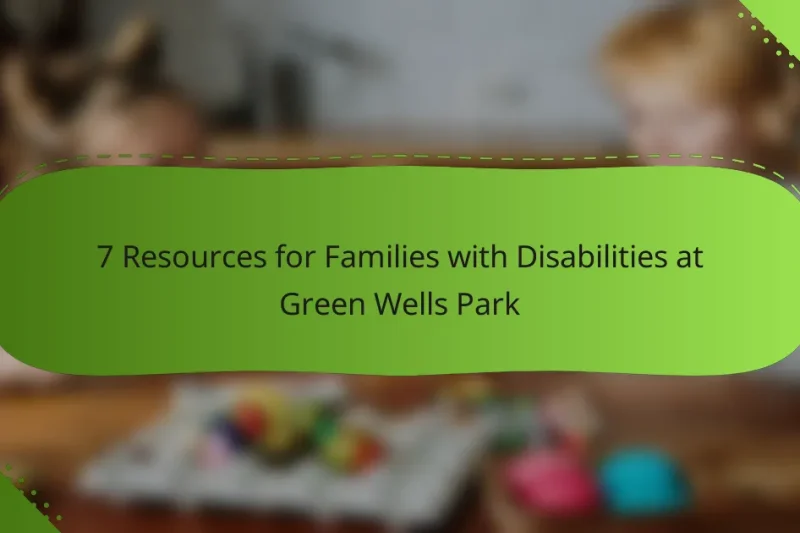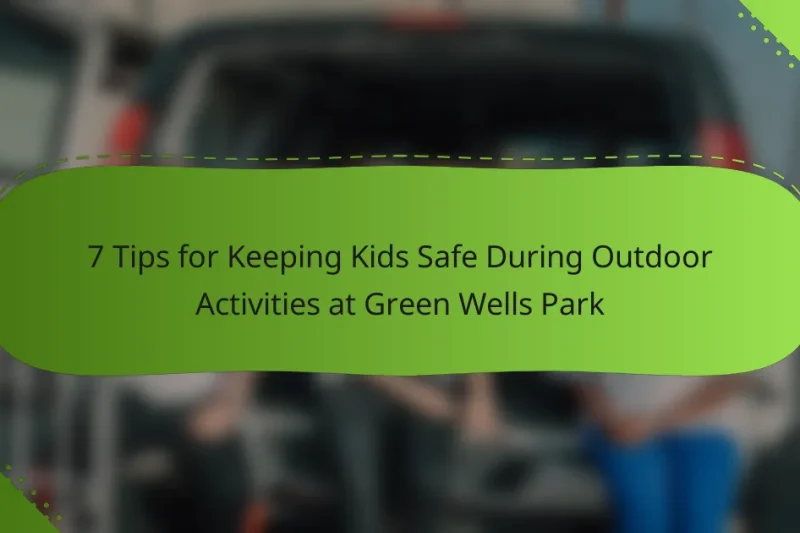When visiting Green Wells Park, families should prioritize safety by following essential guidelines that enhance their … 7 Safety Guidelines for Families Visiting Green Wells ParkRead more
Family Fun Park Safety and Accessibility
Ensuring a safe and enjoyable experience at family fun parks involves understanding safety protocols and ride requirements while actively monitoring children’s behavior. Additionally, parks prioritize accessibility by offering features such as wheelchair ramps and assistive devices, making it possible for all visitors to participate in the fun. Specialized accommodations for children with disabilities further enhance inclusivity, allowing everyone to enjoy the attractions safely.
7 Resources for Families with Disabilities at Green Wells Park
Green Wells Park is dedicated to creating an inclusive environment for families with disabilities by offering … 7 Resources for Families with Disabilities at Green Wells ParkRead more
7 Tips for Navigating Green Wells Park with Strollers
Navigating Green Wells Park with a stroller can be a delightful experience for families looking to … 7 Tips for Navigating Green Wells Park with StrollersRead more
7 Accessibility Features for Families with Special Needs at Green Wells Park
Green Wells Park is dedicated to providing an inclusive experience for families with special needs through … 7 Accessibility Features for Families with Special Needs at Green Wells ParkRead more
7 Tips for Keeping Kids Safe During Outdoor Activities at Green Wells Park
Ensuring the safety of children during outdoor activities at Green Wells Park is essential for a … 7 Tips for Keeping Kids Safe During Outdoor Activities at Green Wells ParkRead more
How can families ensure safety at amusement parks?
Families can ensure safety at amusement parks by being aware of safety protocols, understanding ride requirements, and monitoring their children’s behavior. Engaging with park staff and familiarizing themselves with emergency procedures can further enhance safety for everyone.
Regular safety inspections
Amusement parks conduct regular safety inspections to identify and rectify potential hazards. These inspections typically occur daily, weekly, or monthly, depending on the ride and local regulations. Families should look for visible signs of maintenance and inquire about the park’s inspection schedule.
Inspections often include checking ride mechanics, safety equipment, and overall park cleanliness. A well-maintained park is a key indicator of a commitment to safety.
Staff training programs
Staff training programs are essential for ensuring that employees are equipped to handle safety issues effectively. These programs often cover emergency procedures, customer service, and specific ride operations. Families should feel reassured knowing that well-trained staff are present to assist in emergencies.
Regular refresher courses help staff stay updated on safety protocols and best practices. Families can ask staff about their training to gauge their preparedness.
Emergency response protocols
Emergency response protocols are critical for managing incidents swiftly and efficiently. Parks typically have clear procedures for various emergencies, including medical situations and ride malfunctions. Families should familiarize themselves with these protocols upon arrival.
Look for emergency exits, first aid stations, and staff who can provide assistance. Knowing where to go in case of an emergency can save valuable time and ensure safety.
Child safety measures
Child safety measures are implemented to protect younger visitors throughout the park. This includes height restrictions for rides, designated play areas, and child identification systems. Parents should always check height requirements before allowing their children on rides.
Using wristbands or tags can help keep track of children, especially in crowded areas. Establishing a meeting point in case of separation can also enhance safety.
Ride safety standards
Ride safety standards are established to ensure that all attractions meet specific safety criteria. These standards often include regular maintenance checks and adherence to manufacturer guidelines. Families should look for posted safety information near rides to understand the safety measures in place.
Understanding the ride’s safety features, such as harnesses and emergency shut-off systems, can help families make informed decisions about which rides are appropriate for their children. Always prioritize rides that comply with recognized safety standards.
What accessibility features should family fun parks offer?
Family fun parks should provide a range of accessibility features to ensure all visitors can enjoy their experience. Key elements include wheelchair ramps, accessible restrooms, service animal policies, and the availability of assistive devices.
Wheelchair ramps and paths
Wheelchair ramps and accessible paths are essential for allowing individuals with mobility challenges to navigate the park. Ramps should have a gentle slope, typically not exceeding a 1:12 ratio, and be made of non-slip materials. Clearly marked paths should connect all major attractions, ensuring easy access.
Regular maintenance is crucial to keep these pathways clear of obstacles. Parks should also consider providing tactile ground surface indicators to assist visually impaired guests in navigating the area safely.
Accessible restrooms
Accessible restrooms must be available throughout the park, featuring wider stalls, grab bars, and accessible sinks. These facilities should be clearly marked with universal symbols to guide visitors. It is advisable to have at least one accessible restroom in each restroom block to accommodate varying needs.
Regular checks and maintenance of these facilities are necessary to ensure cleanliness and functionality. Providing additional amenities, such as baby-changing stations in accessible restrooms, can enhance the experience for families with young children.
Service animal policies
Family fun parks should have clear service animal policies that comply with local regulations. Typically, service animals are defined as dogs trained to perform specific tasks for individuals with disabilities. Parks should allow these animals in all areas where guests are permitted.
It is important to provide information on the park’s website regarding the service animal policy, including any required documentation. Staff training on how to assist guests with service animals can also improve the overall experience for all visitors.
Assistive devices availability
Offering assistive devices, such as wheelchairs, scooters, or mobility aids, can significantly enhance accessibility for guests. Parks should provide rental services for these devices at convenient locations, ideally near the entrance. Clear signage and information on availability should be provided to inform guests ahead of their visit.
Additionally, parks may consider offering sensory-friendly equipment, such as noise-canceling headphones or fidget tools, to support guests with sensory sensitivities. Ensuring these devices are well-maintained and easily accessible can create a more inclusive environment for everyone.
How do family fun parks accommodate children with disabilities?
Family fun parks implement various strategies to ensure children with disabilities can enjoy their facilities safely and inclusively. These accommodations often include specialized ride access, quiet areas for sensory breaks, and personalized assistance services tailored to individual needs.
Specialized ride access
Many family fun parks offer specialized ride access to ensure children with disabilities can participate in attractions. This may involve modified seating, additional safety harnesses, or designated loading areas that accommodate wheelchairs or mobility devices.
Parents should inquire about specific rides that offer these accommodations and the process for accessing them. Some parks may require advance notice or provide a special pass to facilitate quicker access to rides.
Quiet areas for sensory breaks
Quiet areas are designated spaces within family fun parks where children can take sensory breaks away from the noise and excitement. These areas often feature calming environments with comfortable seating, soft lighting, and minimal stimulation.
It is advisable for parents to locate these quiet areas upon arrival to ensure they can quickly access them when needed. Some parks may also provide sensory kits with items like noise-canceling headphones or fidget toys to help children self-regulate.
Personalized assistance services
Family fun parks frequently offer personalized assistance services to support children with disabilities. This can include trained staff members who provide guidance, help with navigating the park, or assistance during rides.
Parents should check if the park offers a buddy system or personal guides, which can enhance the experience for children requiring additional support. It is beneficial to communicate specific needs to park staff to ensure appropriate accommodations are made.
What are the legal requirements for safety and accessibility?
Legal requirements for safety and accessibility at family fun parks typically include compliance with federal and local regulations that ensure safe environments for all visitors, including those with disabilities. Understanding these requirements is essential for park operators to provide a secure and inclusive experience.
Americans with Disabilities Act (ADA) compliance
The Americans with Disabilities Act (ADA) mandates that public spaces, including family fun parks, must be accessible to individuals with disabilities. This includes providing accessible pathways, restrooms, and attractions that accommodate various mobility needs.
To comply with ADA standards, parks should regularly assess their facilities and implement necessary modifications. For example, installing ramps, offering accessible seating, and ensuring that signage is clear and easy to read can significantly enhance accessibility.
Local safety regulations
Local safety regulations vary by jurisdiction but generally require family fun parks to adhere to specific safety standards to protect visitors. These regulations often cover ride safety inspections, emergency procedures, and general maintenance of facilities.
Parks should familiarize themselves with local codes and conduct regular safety audits. For instance, ensuring that rides are inspected annually and that staff are trained in emergency response can help mitigate risks and enhance visitor safety.
How can families find safe and accessible parks?
Families can find safe and accessible parks by researching online resources, reading reviews, and consulting accessibility guides. These tools help identify parks that meet safety standards and provide facilities for individuals with disabilities.
Online reviews and ratings
Online reviews and ratings are valuable for assessing the safety and accessibility of parks. Websites like Yelp, TripAdvisor, and Google Reviews often feature user-generated content that highlights experiences related to park conditions, safety measures, and accessibility features.
When reading reviews, look for comments about specific amenities such as wheelchair ramps, accessible restrooms, and playground equipment designed for children with disabilities. Pay attention to the overall ratings, as higher scores generally indicate better experiences.
Accessibility guides and resources
Accessibility guides and resources provide detailed information about park facilities and services for individuals with disabilities. Organizations like the National Park Service and local disability advocacy groups often publish guides that outline accessibility features in various parks.
Families can also find online databases that list parks with specific accessibility options. These resources typically include information on parking, pathways, and available equipment, helping families make informed decisions about where to visit.




